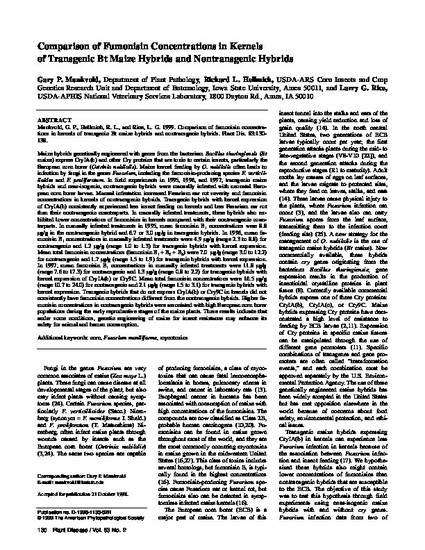
Maize hybrids genetically engineered with genes from the bacteriumBacillus thuringiensis (Bt maize) express CryIA(b) and other Cry proteins that are toxic to certain insects, particularly the European corn borer (Ostrinia nubilalis). Maize kernel feeding by O. nubilalis often leads to infection by fungi in the genus Fusarium, including the fumonisin-producing species F. verticillioides and F. proliferatum. In field experiments in 1995, 1996, and 1997, transgenic maize hybrids and near-isogenic, nontransgenic hybrids were manually infested with neonatal European corn borer larvae. Manual infestation increased Fusarium ear rot severity and fumonisin concentrations in kernels of nontransgenic hybrids. Transgenic hybrids with kernel expression of CryIA(b) consistently experienced less insect feeding on kernels and less Fusarium ear rot than their nontransgenic counterparts. In manually infested treatments, these hybrids also exhibited lower concentrations of fumonisins in kernels compared with their nontransgenic counterparts. In manually infested treatments in 1995, mean fumonisin B1 concentrations were 8.8 μg/g in the nontransgenic hybrid and 6.7 or 3.0 μg/g in transgenic hybrids. In 1996, mean fumonisin B1 concentrations in manually infested treatments were 4.9 μg/g (range 2.3 to 8.8) for nontransgenic and 1.2 μg/g (range 1.0 to 1.3) for transgenic hybrids with kernel expression. Mean total fumonisin concentrations (fumonisin B1 + B2 + B3) were 7.0 μg/g (range 3.0 to 12.2) for nontransgenic and 1.7 μg/g (range 1.5 to 1.9) for transgenic hybrids with kernel expression. In 1997, mean fumonisin B1 concentrations in manually infested treatments were 11.8 μg/g (range 7.6 to 17.3) for nontransgenic and 1.3 μg/g (range 0.8 to 2.2) for transgenic hybrids with kernel expression of CryIA(b) or Cry9C. Mean total fumonisin concentrations were 16.5 μg/g (range 10.7 to 24.0) for nontransgenic and 2.1 μg/g (range 1.5 to 3.1) for transgenic hybrids with kernel expression. Transgenic hybrids that do not express CryIA(b) or Cry9C in kernels did not consistently have fumonisin concentrations different from the nontransgenic hybrids. Higher fumonisin concentrations in nontransgenic hybrids were associated with high European corn borer populations during the early reproductive stages of the maize plants. These results indicate that under some conditions, genetic engineering of maize for insect resistance may enhance its safety for animal and human consumption.
Available at: http://works.bepress.com/richard_hellmich/54/

This article is from Plant Disease; vol.83 (1999); 130-138; doi: 10.1094/PDIS.1999.83.2.130.